Visible Light Enhancement of Biocarbon Quantum-Dot-Decorated TiO2 for Naphthalene Removal
Abstract
:1. Introduction
2. Results
2.1. Effect of Dilute Sulfuric Acid Pretreatment on CQDs
2.2. Characterization of CQDs and CQD/TiO2
2.3. UV–Vis Analysis of CQD/TiO2
2.4. FTIR Analysis of CQD/TiO2
2.5. XPS Analysis of CQD/TiO2
2.6. Photocatalytic Performance of CQD/TiO2 on Naphthalene Removal
3. Discussion
3.1. Photocatalytic Mechanism Analysis of CQD/TiO2 on Naphthalene Removal
3.2. Kinetic Model Analysis of Naphthalene Removal by CQD/TiO2
4. Materials and Methods
4.1. Materials
4.2. Preparation of CQDs and CQD/TiO2
4.3. Characterization of CQDs and CQD/TiO2
4.4. Photocatalytic Activity Measurements
5. Conclusions
Supplementary Materials
Author Contributions
Funding
Data Availability Statement
Acknowledgments
Conflicts of Interest
References
- Vijayanand, M.; Ramakrishnan, A.; Subramanian, R.; Issac, P.K.; Nasr, M.; Khoo, K.; Rajagopal, R.; Greff, B.; Wan, A.N.; Jeon, B.H.; et al. Polyaromatic hydrocarbons (PAHs) in the water environment: A review on toxicity, microbial biodegradation, systematic biological advancements, and environmental fate. Environ. Res. 2023, 227, 115716. [Google Scholar] [CrossRef]
- Zeng, G.; You, H.; Du, M.; Zhang, Y.; Ding, Y.; Xu, C.; Liu, B.; Chen, B.; Pan, X. Enhancement of photocatalytic activity of TiO2 by immobilization on activated carbon for degradation of aquatic naphthalene under sunlight irradiation. Chem. Eng. J. 2021, 412, 128498. [Google Scholar] [CrossRef]
- Monteiro, F.C.; Guimaraes, I.D.L.; Rodrigues, P.D.A. Degradation of pahs using TiO2 as a semiconductor in the heterogeneous photocatalysis process: A systematic review. J. Photochem. Photobiol. A Chem. 2023, 437, 114497. [Google Scholar] [CrossRef]
- Abdel-Latif, H.M.; Dawood, M.A.; Menanteau-Ledouble, S.; El-Matbouli, M. Environmental transformation of n-TiO2 in the aquatic systems and their ecotoxicity in bivalve mollusks: A systematic review. Ecotoxicol. Environ. Saf. 2020, 200, 110776. [Google Scholar] [CrossRef] [PubMed]
- Lettieri, S.; Pavone, M.; Fioravanti, A.; Santamaria Amato, L.; Maddalena, P. Charge carrier processes and optical properties in TiO2 and TiO2-based heterojunction photocatalysts: A review. Materials 2021, 14, 1645. [Google Scholar] [CrossRef]
- Li, F.; Liu, G.; Liu, F.; Wu, J.; Yang, S. Synergetic effect of cqd and oxygen vacancy to TiO2 photocatalyst for boosting visible photocatalytic no removal. J. Hazard. Mater. 2023, 452, 131237. [Google Scholar] [CrossRef] [PubMed]
- Yu, X.; Liu, J.; Yu, Y.; Zuo, S.; Li, B. Preparation and visible light photocatalytic activity of carbon quantum dots/TiO2 nanosheet composites. Carbon 2014, 68, 718–724. [Google Scholar] [CrossRef]
- García de Arquer, F.P.; Talapin, D.V.; Klimov, V.I.; Arakawa, Y.; Bayer, M.; Sargent, E.H. Semiconductor quantum dots: Technological progress and future challenges. Science 2021, 373, eaaz8541. [Google Scholar] [CrossRef] [PubMed]
- Zhang, Z.; Liu, H.; Xu, J.; Zeng, H. Carbon quantum dots/ biponanocomposites with enhanced visible-light absorption and charge separation. J. Photochem. Photobiol. A Chem. 2017, 336, 25–31. [Google Scholar] [CrossRef]
- Pourreza, N.; Ghomi, M. Green synthesized carbon quantum dots from Prosopis juliflora leaves as a dual off-on fluorescence probe for sensing mercury (II) and chemet drug. Mater. Sci. Eng. C 2019, 98, 887–896. [Google Scholar] [CrossRef]
- Das, G.S.; Shim, J.P.; Bhatnagar, A.; Tripathi, K.M.; Kim, T.Y. Biomass-derived carbon quantum dots for visible-light-induced photocatalysis and label-free detection of Fe(III) and ascorbic acid. Sci. Rep. 2019, 9, 15084. [Google Scholar] [CrossRef]
- Smetacek, V.; Adriana, Z. Green and golden seaweed tides on the rise. Nature 2013, 504, 84–88. [Google Scholar] [CrossRef]
- Zhang, L.Y.; Han, Y.L.; Yang, J.J.; Deng, S.L.; Wang, B.Y. Construction and photocatalysis of carbon quantum dots/layered mesoporous titanium dioxide (cqds/lm-TiO2) composites. Appl. Surf. Sci. 2021, 546, 149089. [Google Scholar] [CrossRef]
- Piątkowska, A.; Janus, M.; Szymański, K.; Mozia, S. C-, N-and S-doped TiO2 photocatalysts: A review. Catalysts 2021, 11, 144. [Google Scholar] [CrossRef]
- Sajan, C.P.; Wageh, S.; Al-Ghamdi, A.A.; Yu, J.; Cao, S. TiO2 nanosheets with exposed {001} facets for photocatalytic applications. Nano Res. 2016, 9, 3–27. [Google Scholar] [CrossRef]
- Mei, A.; Xu, Z.; Wang, X.; Liu, Y.; Chen, J.; Fan, J.; Shi, Q. Photocatalytic materials modified with carbon quantum dots for the degradation of organic pollutants under visible light: A review. Environ. Res. 2022, 214, 114160. [Google Scholar] [CrossRef]
- Lim, S.Y.; Shen, W.; Gao, Z. Carbon quantum dots and their applications. Chem. Soc. Rev. 2015, 44, 362–381. [Google Scholar] [CrossRef]
- Yin, K.; Yan, Z.; Fang, N.; Yu, W.; Chu, Y.; Shu, S.; Xu, M. The synergistic effect of surface vacancies and heterojunctions for efficient photocatalysis: A review. Sep. Purif. Technol. 2023, 325, 124636. [Google Scholar] [CrossRef]
- Khan, M.E.; Mohammad, A.; Yoon, T. State-of-the-art developments in carbon quantum dots (CQDs): Photo-catalysis, bio-imaging, and bio-sensing applications. Chemosphere 2022, 302, 134815. [Google Scholar] [CrossRef]
- Marković, Z.M.; Labudová, M.; Danko, M.; Matijasević, D.; Mičušík, M.; Nádaždy, V.; Kováčová, M.; Kleinová, A.; Špitalský, Z.; Pavlović, V.; et al. Highly efficient antioxidant F- and Cl-doped carbon quantum dots for bioimaging. ACS Sustain. Chem. Eng. 2020, 8, 16327–16338. [Google Scholar] [CrossRef]
- Cao, F.J.; Hou, X.; Wang, K.F.; Jin, T.Z.; Feng, H. Facile synthesis of phosphorus and nitrogen co-doped carbon dots with excellent fluorescence emission towards cellular imaging. RSC Adv. 2023, 13, 21088–21095. [Google Scholar] [CrossRef] [PubMed]
- Tajik, S.; Dourandish, Z.; Zhang, K.; Beitollahi, H.; Le, Q.V.; Jang, H.W.; Shokouhimehr, M. Carbon and graphene quantum dots: A review on syntheses, characterization, biological and sensing applications for neurotransmitter determination. RSC Adv. 2020, 10, 15406–15429. [Google Scholar] [CrossRef] [PubMed]
- Deb, A.; Chowdhury, D. Biogenic carbon quantum dots: Synthesis and applications. Curr. Med. Chem. 2024, 30, 37291790. [Google Scholar] [CrossRef] [PubMed]
- He, Z.; Sun, Y.; Zhang, C.; Zhang, J.; Liu, S.; Zhang, K.; Lan, M. Recent advances of solvent-engineered carbon dots: A review. Carbon 2023, 204, 76–93. [Google Scholar] [CrossRef]
- Wareing, T.C.; Gentile, P.; Phan, A.N. Biomass-based carbon dots: Current development and future perspectives. ACS Nano 2021, 15, 15471–15501. [Google Scholar] [CrossRef] [PubMed]
- Pinna, M.; Binda, G.; Altomare, M.; Marelli, M.; Dossi, C.; Monticelli, D.; Spanu, D.; Recchia, S. Biochar nanoparticles over TiO2 nanotube arrays: A green co-catalyst to boost the photocatalytic degradation of organic pollutants. Catalysts 2021, 11, 1048. [Google Scholar] [CrossRef]
- Nu, T.T.V.; Tran, N.H.T.; Truong, P.L.; Phan, B.T.; Dinh, M.T.N.; Dinh, V.P.; Phan, T.S.; Go, S.; Chang, M.; Trinh, K.T.L.; et al. Green synthesis of microalgae-based carbon dots for decoration of TiO2 nanoparticles in enhancement of organic dye photodegradation. Environ. Res. 2022, 206, 112631. [Google Scholar] [CrossRef] [PubMed]
- Guo, J.; Guo, X.; Yang, H.; Zhang, D.; Jiang, X. Construction of Bio-TiO2/Algae Complex and Synergetic Mechanism of the Acceleration of Phenol Biodegradation. Materials 2023, 16, 3882. [Google Scholar] [CrossRef] [PubMed]
- Lai, C.; Yang, B.; He, J.; Huang, C.; Li, X.; Song, X.; Yong, Q. Enhanced enzymatic digestibility of mixed wood sawdust by lignin modification with naphthol derivatives during dilute acid pretreatment. Bioresour. Technol. 2018, 269, 18–24. [Google Scholar] [CrossRef]
- Ghatak, H.R. Biorefineries from the perspective of sustainability: Feedstocks, products, and processes. Renew. Sustain. Energy Rev. 2011, 15, 4042–4052. [Google Scholar] [CrossRef]
- Zeng, G.; Hong, C.; Ma, Y.; Du, M.; Zhang, Y.; Luo, H.; Chen, B.; Pan, X. Sargassum Horneri based carbon doped TiO2 and its aquatic naphthalene photo-degradation under sunlight irradiation. J. Chem. Technol. Biotechnol. 2022, 97, 1267–1274. [Google Scholar] [CrossRef]
- Bian, J.; Huang, C.; Wang, L.; Hung, T.F.; Daoud, W.A.; Zhang, R. Carbon dot loading and TiO2 nanorod length dependence of photoelectrochemical properties in carbon dot/TiO2 nanorod array nanocomposites. ACS Appl. Mater. Interfaces 2014, 6, 4883–4890. [Google Scholar] [CrossRef] [PubMed]
- Gao, W.; Zhang, S.; Wang, G.; Cui, J.; Lu, Y.; Rong, X.; Gao, C. A review on mechanism, applications and influencing factors of carbon quantum dots based photocatalysis. Ceram. Int. 2022, 48, 35986–35999. [Google Scholar] [CrossRef]
- Natarajan, S.; Bajaj, H.; Tayade, R. Recent advances based on the synergetic effect of adsorption for removal of dyes from waste water using photocatalytic process. J. Environ. Sci. 2018, 30, 201–222. [Google Scholar] [CrossRef]
- Tsao, C.W.; Narra, S.; Kao, J.C.; Lin, Y.C.; Chen, C.Y.; Chin, Y.C.; Huang, Z.J.; Huang, W.H.; Huang, C.C.; Luo, C.W.; et al. Dual-plasmonic Au@ Cu7S4 yolk@ shell nanocrystals for photocatalytic hydrogen production across visible to near infrared spectral region. Nat. Commun. 2024, 15, 413. [Google Scholar] [CrossRef] [PubMed]
- Chen, J.; Shu, J.; Anqi, Z.; Juyuan, H.; Yan, Z.; Chen, J. Synthesis of carbon quantum dots/TiO2 nanocomposite for photo-degradation of Rhodamine B and cefradine. Diam. Relat. Mater. 2016, 70, 137–144. [Google Scholar] [CrossRef]
- He, C.; Peng, L.; Lv, L.; Cao, Y.; Tu, J.; Huang, W.; Zhang, K. In situ growth of carbon dots on TiO2 nanotube arrays for PEC enzyme biosensors with visible light response. RSC Adv. 2019, 9, 15084–15091. [Google Scholar] [CrossRef] [PubMed]
- Zhang, J.; Zhang, X.; Dong, S.; Zhou, X.; Dong, S. N-doped carbon quantum dots/tio2 hybrid composites with enhanced visible light driven photocatalytic activity toward dye wastewater degradation and mechanism insight. J. Photochem. Photobiol. A Chem. 2016, 325, 104–110. [Google Scholar] [CrossRef]
- Tsao, C.W.; Fang, M.J.; Hsu, Y.J. Modulation of interfacial charge dynamics of semiconductor heterostructures for advanced photocatalytic applications. Coord. Chem. Rev. 2021, 438, 213876. [Google Scholar] [CrossRef]
- Pirsaheb, M.; Asadi, A.; Sillanpää, M.; Farhadian, N. Application of carbon quantum dots to increase the activity of conventional photocatalysts: A systematic review. J. Mol. Liq. 2018, 271, 857–871. [Google Scholar] [CrossRef]
- Peñas-Garzón, M.; Gómez-Avilés, A.; Bedia, J.; Rodriguez, J.J.; Belver, C. Effect of activating agent on the properties of TiO2/activated carbon heterostructures for solar photocatalytic degradation of acetaminophen. Materials 2019, 12, 378. [Google Scholar] [CrossRef] [PubMed]
- Baruah, M.; Supong, A.; Bhomick, P.C.; Karmaker, R.; Pongener, C.; Sinha, D. Batch sorption-photodegradation of Alizarin Red S using synthesized TiO2/activated carbon nanocomposite: An experimental study and computer modelling. Nanotechnol. Environ. Eng. 2020, 5, 8. [Google Scholar] [CrossRef]
- John, V.L.; Nair, Y.; Vinod, T.P. Doping and surface modification of carbon quantum dots for enhanced functionalities and related applications. Part. Part. Syst. Charact. 2021, 38, 2100170. [Google Scholar] [CrossRef]
- Chiu, Y.H.; Chang, T.F.M.; Chen, C.Y.; Sone, M.; Hsu, Y.J. Mechanistic insights into photodegradation of organic dyes using heterostructure photocatalysts. Catalysts 2019, 9, 430. [Google Scholar] [CrossRef]
- Zhang, S.; Zhang, Z.; Li, B.; Dai, W.; Si, Y.; Yang, L.; Luo, S. Hierarchical Ag3PO4@ ZnIn2S4 nanoscoparium: An innovative Z-scheme photocatalyst for highly efficient and predictable tetracycline degradation. J. Colloid Interface Sci. 2021, 586, 708–718. [Google Scholar] [CrossRef] [PubMed]
- Yan, Z.; Yin, K.; Xu, M.; Fang, N.; Yu, W.; Chu, Y.; Shu, S. Photocatalysis for synergistic water remediation and H2 production: A review. Chem. Eng. J. 2023, 472, 145066. [Google Scholar] [CrossRef]
- Marković, Z.M.; Kováčová, M.; Jeremić, S.R.; Nagy, Š.; Milivojević, D.D.; Kubat, P.; Kleinová, A.; Budimir, M.D.; Mojsin, M.M.; Stevanović, M.J.; et al. Highly efficient antibacterial polymer composites based on hydrophobic riboflavin carbon polymerized dots. Nanomaterials 2022, 12, 4070. [Google Scholar] [CrossRef] [PubMed]
- Liu, J.; Zhu, W.; Yu, S.; Yan, X. Three dimensional carbogenic dots/TiO2 nanoheterojunctions with enhanced visible light-driven photocatalytic activity. Carbon 2014, 79, 369–379. [Google Scholar] [CrossRef]
- Hu, C.; Mu, Y.; Li, M.; Qiu, J. Recent advances in the synthesis and applications of carbon dots. Acta Phys.-Chim. Sin. 2019, 35, 572–590. [Google Scholar] [CrossRef]
- Sun, X.; Li, H.J.; Ou, N.; Lyu, B.; Gui, B.; Tian, S.; Qian, D.; Wang, X.; Yang, J. Visible-light driven TiO2 photocatalyst coated with graphene quantum dots of tunable nitrogen doping. Molecules 2019, 24, 344. [Google Scholar] [CrossRef]
- Chang, L.; Ahmad, N.; Zeng, G.; Ray, A.; Zhang, Y. N, S co-doped carbon quantum dots/TiO2 composite for visible-light-driven photocatalytic reduction of Cr (VI). J. Environ. Chem. Eng. 2022, 10, 108742. [Google Scholar] [CrossRef]
- Alvira, P.; Tomás-Pejó, E.; Ballesteros, M.; Negro, M.J. Pretreatment technologies for an efficient bioethanol production process based on enzymatic hydrolysis: A review. Bioresour. Technol. 2010, 101, 4851–4861. [Google Scholar] [CrossRef] [PubMed]
- Fabbri, D.; Adamiano, A.; Torri, C. Gc-ms determination of polycyclic aromatic hydrocarbons evolved from pyrolysis of biomass. Anal. Bioanal. Chem. 2010, 397, 309–317. [Google Scholar] [CrossRef] [PubMed]

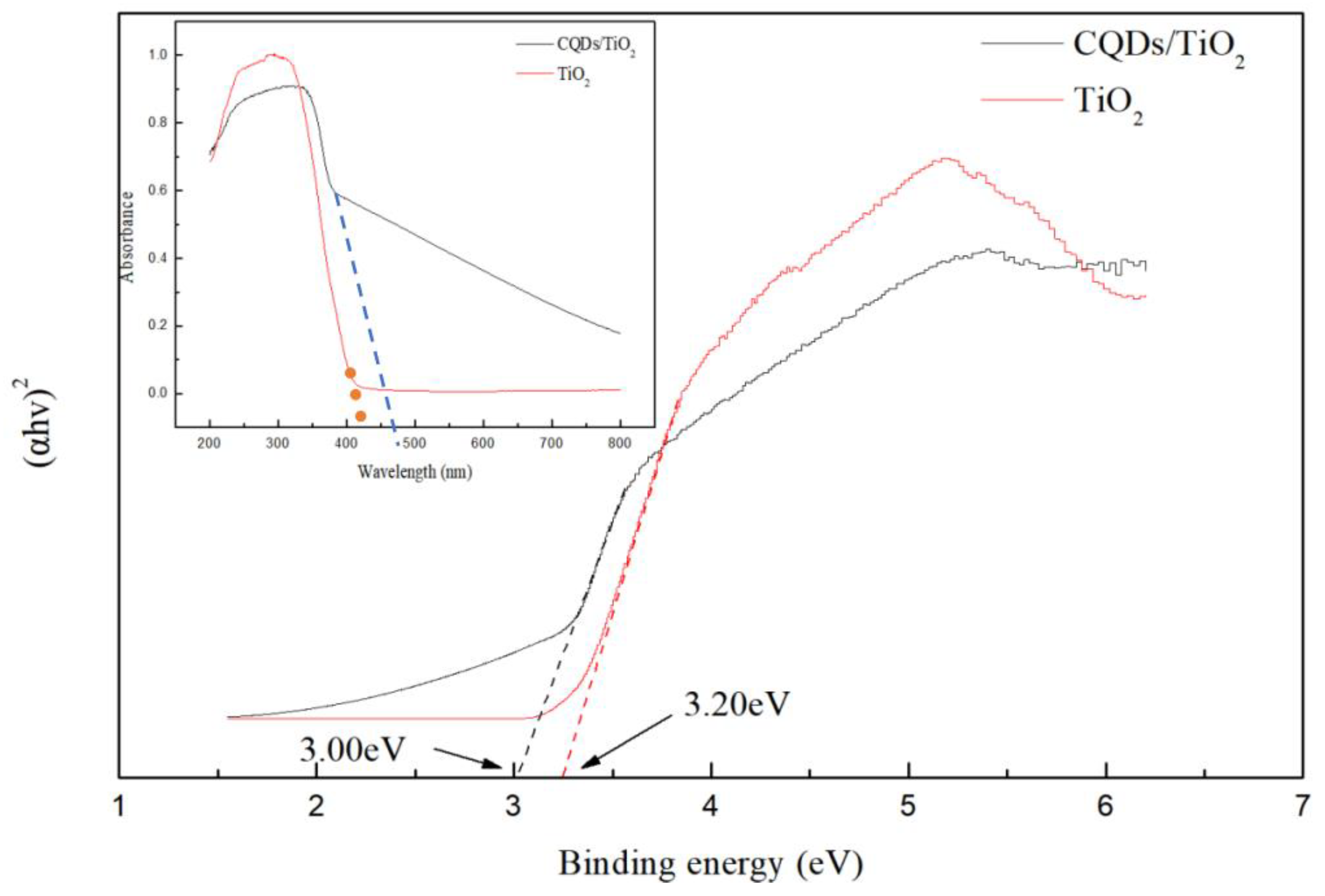
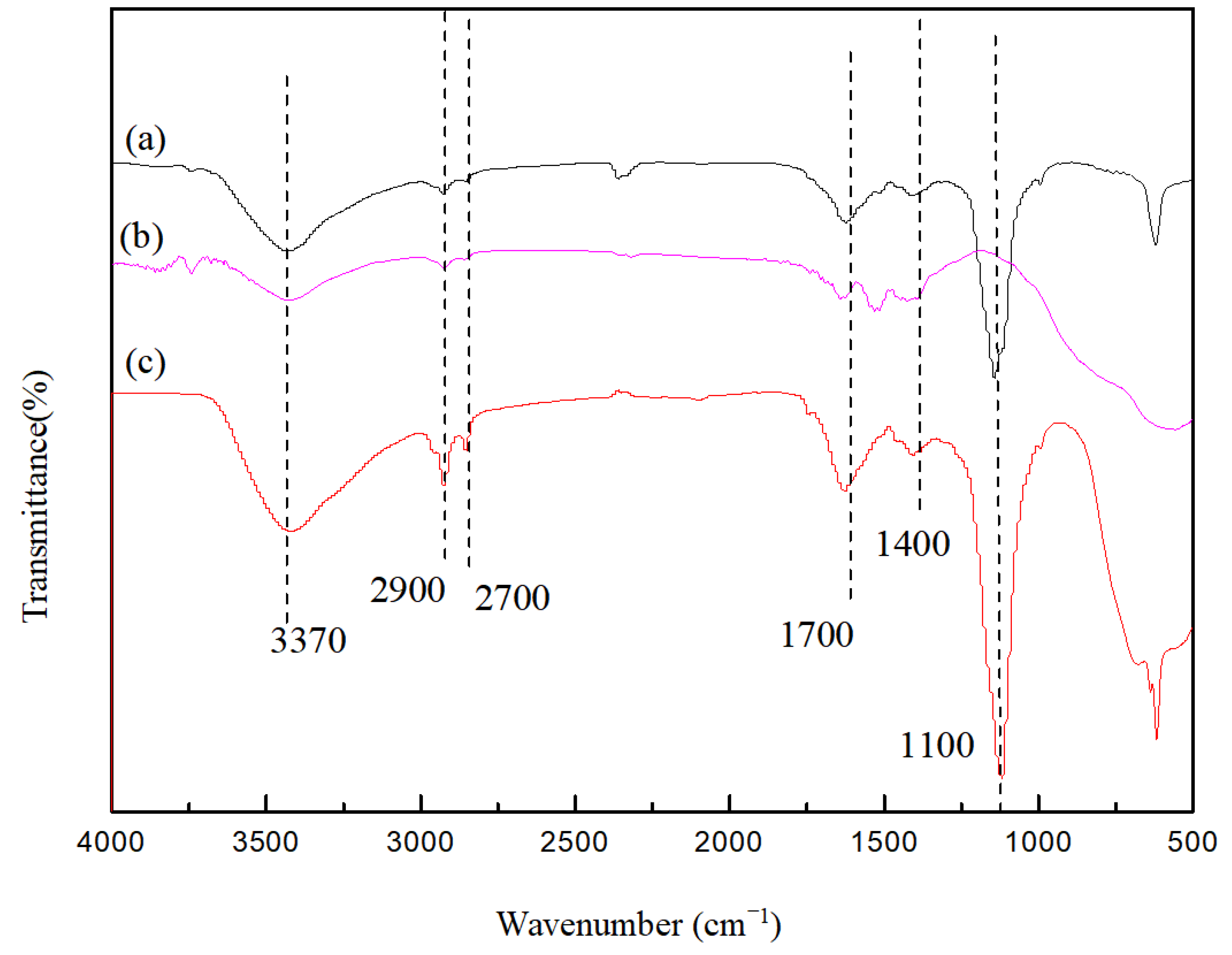
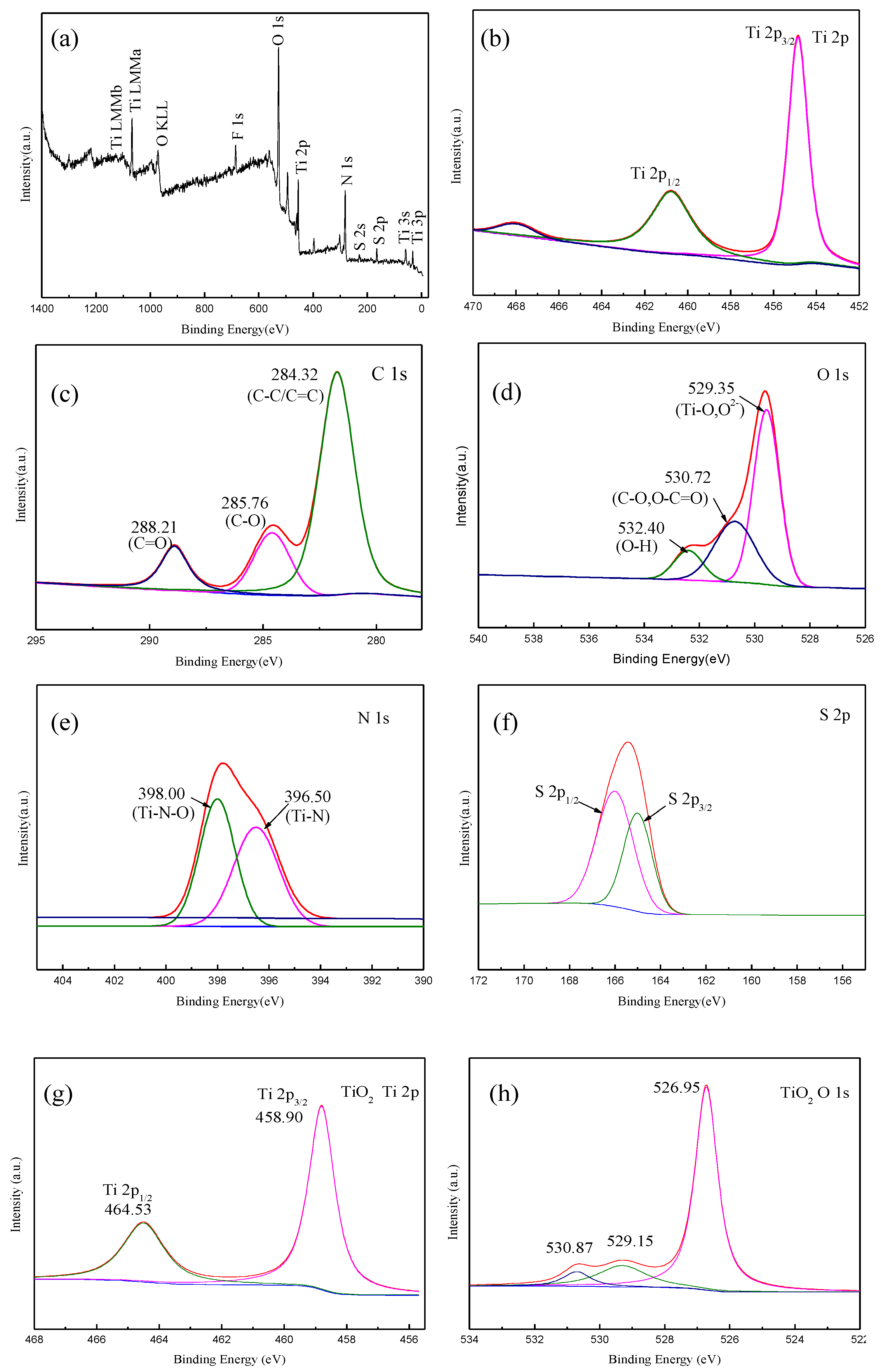
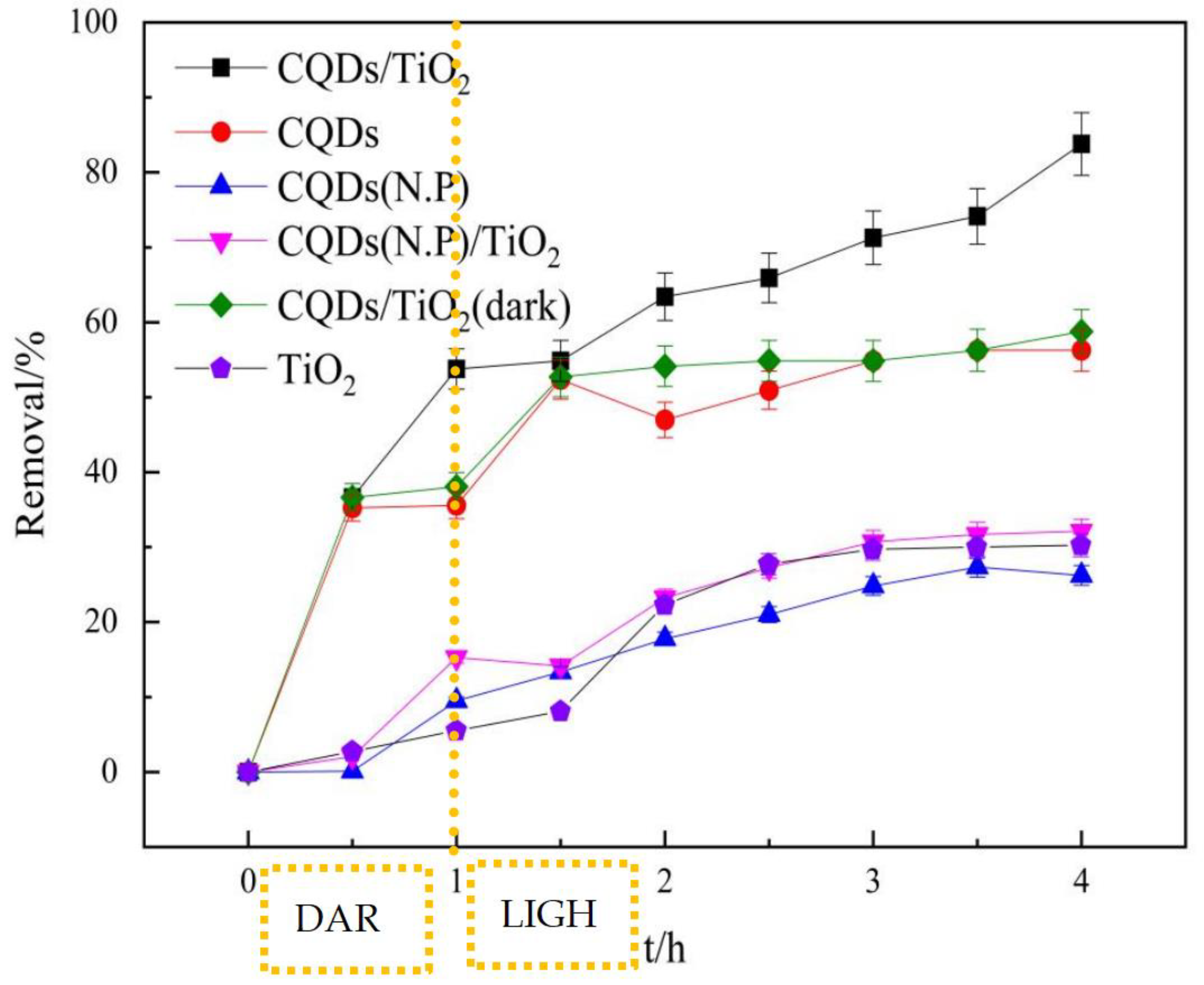
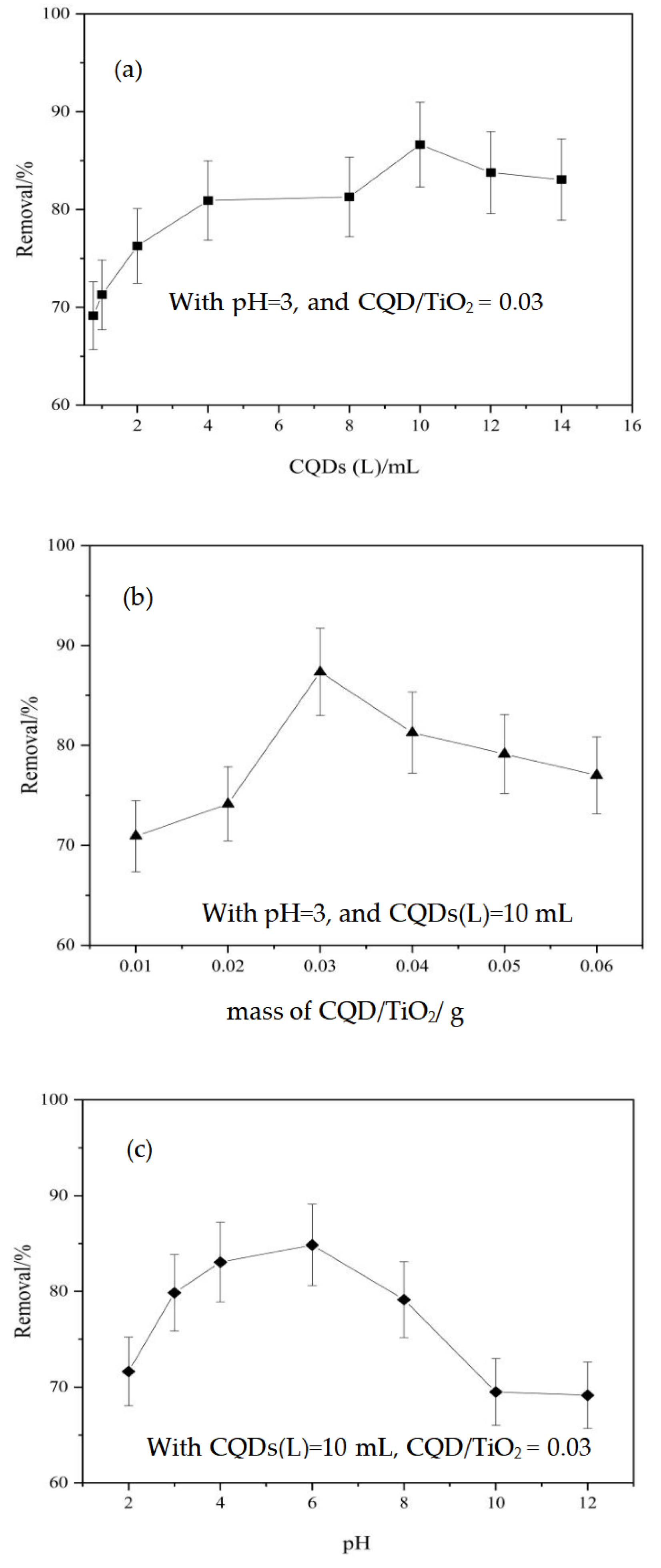


| Kinetic Model | Parameters | Samples | ||
|---|---|---|---|---|
| CQD/TiO2 | CQD/TiO2 (dark) | CQDs | ||
| Pseudo-first-order | k1 × 102/(min−1) | 0.603 | 0.008 | 0.104 |
| R2 | 0.8968 | 0.8608 | 0.4932 | |
| Pseudo-second-order | k2 × 104/(L·mg−1·min−1) | 5.642 | 0.447 | 0.552 |
| R2 | 0.7764 | 0.8480 | 0.5179 | |
| Double exponential | A1 | −41.89 | −29.56 | −28.14 |
| A2 | −41.89 | −29.56 | −28.14 | |
| k3 | 0.0588 | 0.0214 | 0.1529 | |
| k4 | 0.0588 | 0.0214 | 0.1529 | |
| R2 | −0.4477 | 0.2531 | 0.9150 | |
Disclaimer/Publisher’s Note: The statements, opinions and data contained in all publications are solely those of the individual author(s) and contributor(s) and not of MDPI and/or the editor(s). MDPI and/or the editor(s) disclaim responsibility for any injury to people or property resulting from any ideas, methods, instructions or products referred to in the content. |
© 2024 by the authors. Licensee MDPI, Basel, Switzerland. This article is an open access article distributed under the terms and conditions of the Creative Commons Attribution (CC BY) license (https://creativecommons.org/licenses/by/4.0/).
Share and Cite
Chen, Y.; Hong, C.; Xu, Q.; Zheng, H.; Wang, C.; Lu, H.; Zhang, S.; Du, M.; Zeng, G. Visible Light Enhancement of Biocarbon Quantum-Dot-Decorated TiO2 for Naphthalene Removal. Molecules 2024, 29, 2708. https://doi.org/10.3390/molecules29112708
Chen Y, Hong C, Xu Q, Zheng H, Wang C, Lu H, Zhang S, Du M, Zeng G. Visible Light Enhancement of Biocarbon Quantum-Dot-Decorated TiO2 for Naphthalene Removal. Molecules. 2024; 29(11):2708. https://doi.org/10.3390/molecules29112708
Chicago/Turabian StyleChen, Yunteng, Chunxian Hong, Qiang Xu, Haihong Zheng, Chao Wang, Hongshun Lu, Shuai Zhang, Mingming Du, and Ganning Zeng. 2024. "Visible Light Enhancement of Biocarbon Quantum-Dot-Decorated TiO2 for Naphthalene Removal" Molecules 29, no. 11: 2708. https://doi.org/10.3390/molecules29112708







